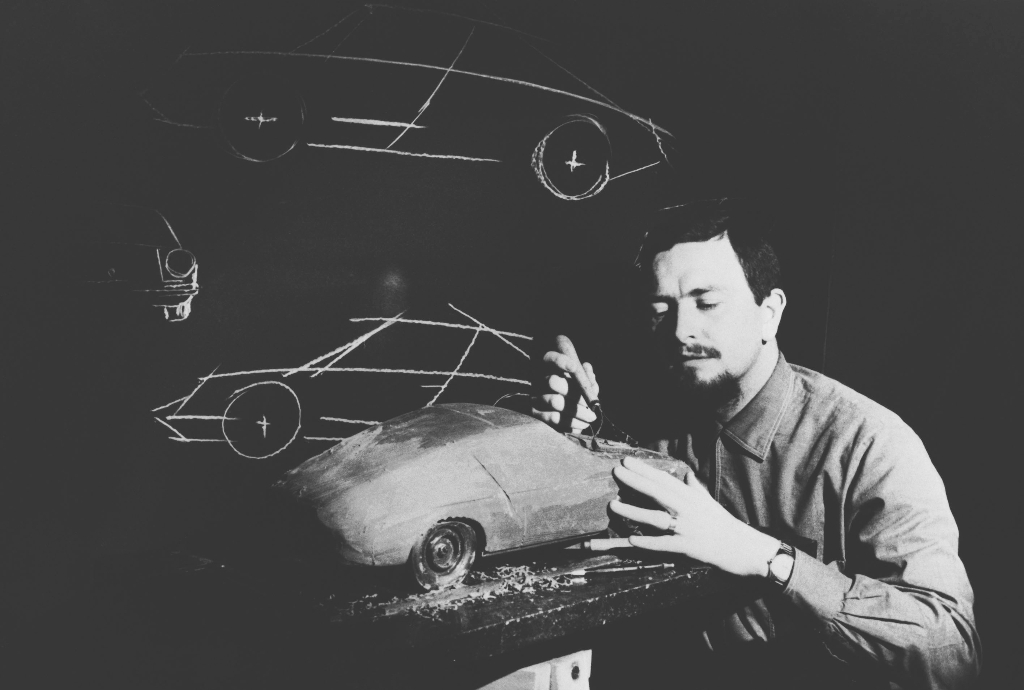
1963: the 901 at IAA

Professor Ferdinand Alexander Porsche applies four fundamental principles in his work: “Reduce everything to its primary function. Focus on the clear and timeless form created in this way. Use the most suitable and progressive materials for this purpose. Choose quality of finish combining tradition in craftsmanship with high technology". And precisely these clear statements might well have served as the starting point for Ferdinand Alexander Porsche's mission more than 40 years ago, when he set out to design the shape and features of the immortal Porsche 911.
Ferdinand Alexander Porsche, the eldest son of Professor Ferry Porsche, has been an independent designer since 1972. In 1974 he and his office moved from Stuttgart to Zell am See, where Ferdinand Alexander Porsche, born in Stuttgart on 11 December 1935, had spent many years in his youth.
In 1950 the family had moved back from Zell am See to Stuttgart, Ferdinand Alexander nicknamed “Butzi" at the time initially going to the local Waldorf School and then attending a boarding school in Switzerland. Following practical training with Bosch, Ferdinand Alexander studied at the Ulm College of Design before starting to work for Porsche in the Company's Design Office. The big step then came in 1960, when F. A., as many abbreviate his first names, joined the Design Department of Porsche KG, subsequently taking over the Design Studio in 1962.
It was in these years that Porsche created the new model destined to take over from the successful 356, the objective being to present the new Porsche at the latest in 1963. To quote Ferdinand Porsche in this context, “creating the new Porsche was a task virtually every designer would have given his heart for. So we – my six colleagues and I – were simply thrilled by our job.
But soon we noticed how great the responsibility was we had set out to assume, since this was not a question of simply building some kind of new car within a large model range. No – we had given ourselves the job to create the successor to a car which itself had long become a classic in more than 1 1/2 decades."
Porsche's President and Chief Executive Officer had given the team a clear brief: “The same dimensions as the 356 plus at least 20 centimetres longer wheelbase for more legroom, and a long, flowing rear end". In response, Ferdinand A. Porsche designed the 754 T7 prototype. “The front end of the T7 was simply great and already looked like the 911 following later. But the main issue was still the overall length of the car and its fastback rear design. My suggestion was to create a little step or notch, placing the rear window just below the edge of the roof." Ferry Porsche, however, was not entirely satisfied with this design of the rear end – “he didn't think it was really Porsche-like", as his son said. Ultimately, therefore, one of the three criteria – long wheelbase, a fastback rear design, and a really attractive look – had to be sacrificed. And as we now know, of course, the wheelbase of the T7 was ultimately shortened, saving enough space along the roof to make the fastback a bit shorter and more compact. “The shorter roof gave the silhouette of the car greater harmony", states the designer of the 901, later to be re-named the 911. Using design language, Ferdinand Alexander Porsche in his profession as a designer referred to the car's “honest and clear shape". And the principle he applies quite appropriately in this context is that “a good product must be discreetly good." Later, he made this statement even more concise and clearer, emphasizing that “design is not fashion". And world-famous designer Otl Aicher once described the 911 by claiming that “this car moves even when it's at a standstill."

The 911 was not the only Porsche to be designed by Ferdinand Alexander. On the contrary, he and his team also created the plastic-bodied 904 racing car presented on the Solitude Race Track in Stuttgart in 1963. To this day, some Porsche experts still regard the 904 as the most beautiful racing car ever built by Porsche. What is less well-known, incidentally, is that even back then F. A. Porsche was studying other objects of design such as aerodynamic, streamlined luggage and ski racks.
Ferdinand Alexander Porsche was the Chairman of the Supervisory Board of Dr. Ing. h.c. F. Porsche AG from 1990 – 1993 and since then he has been a Member of the Supervisory Board. In 1999 he was awarded the honorary title of a Professor in Vienna for his outstanding work on behalf of the Federal President of the Republic of Austria.
Professor Ferdinand Alexander Porsche's maxim in work is clear and straightforward: “The underlying principle in my design work is a very honest concept of freedom. This makes it imperative to query virtually everything we see and to be straightforward, consist and full of responsibility in the freedom of action we obtain and enjoy in this way."

1963: the 901 at IAA
.jpg)
30 Years 911

Porsche Press kit

Porsche Literature

Our Porsche Cars